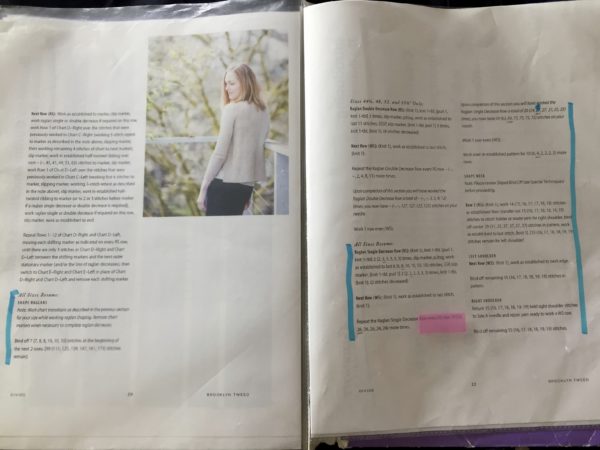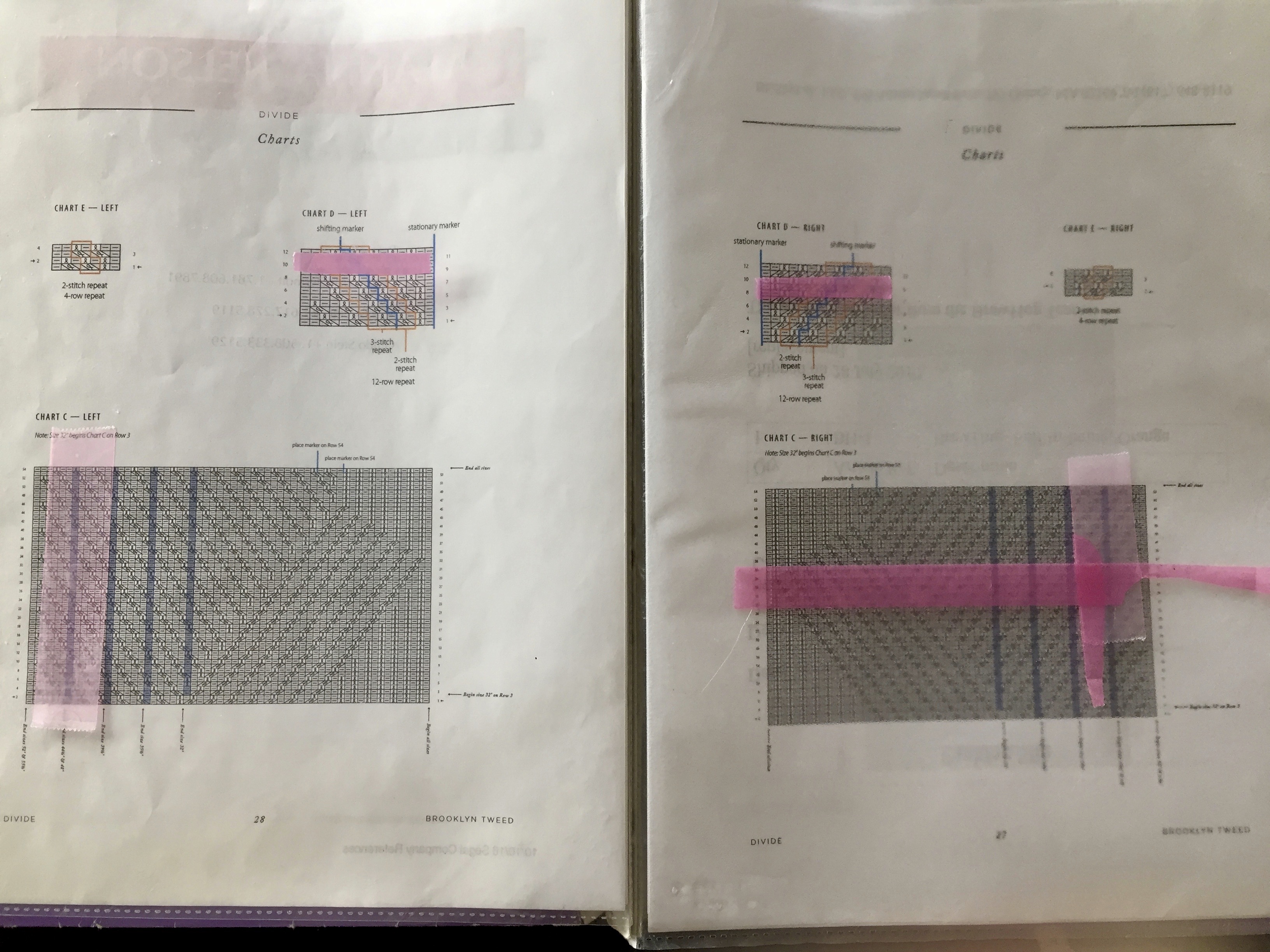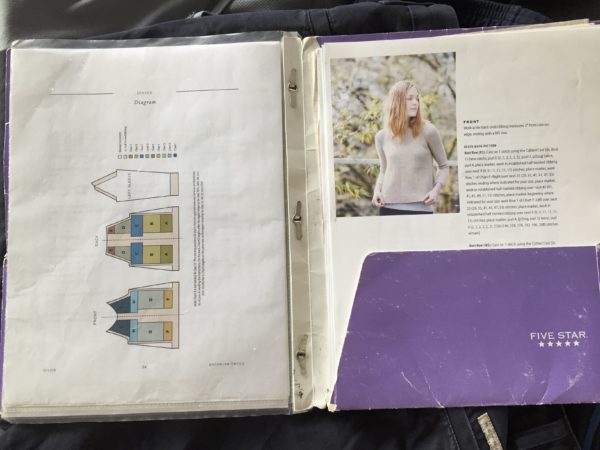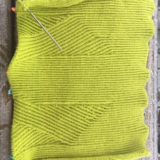The minute I saw the cover of Wool People 11, knitting Emily Greene’s Divide became a priority. Flowing lines and modern details offer an interesting knit and a versatile sweater – love it.
While Divide is written as a pullover, the geometric pattern allows easy adaptation into a cardigan, which I definitely need in my winter wardrobe. A quick stash dive yielded skeins of Hikoo Sueno in a wardrobe neutral chartreuse (yes, chartreuse goes with everything in my closet)… Oh yes, this sweater will be mine!
An admirer of Brooklyn Tweed (BT) since the days when he blogged about his knitting in Brooklyn, I know that Jared values clean graphics and has keen attention detail. I’ve coached many knitters through BT patterns since 2011. The brand’s aesthetic and support of designers is renown.
Hats off to BT for offering a wide size range. Divide instructions range in finished sweaters from 32″ to 55.5″. In this pattern’s layout, the choices made to adapt to the size range complicates its presentation. The instructions reflect a designer’s perspective and not the knitter’s point of view. I hope BT considers pattern presentation strategies to improve the knitter experience.
BT considers Divide an advanced sweater. I found sorting through the pattern the most complicated issue (then again, I’m an advanced knitter). So if you’d like to knit this beauty, here are strategies I used to organize the 39 page pattern:
Pattern organization materials: Digital download of Divide pattern, measuring tape, highlighter marker, highlighter tape, a pocket and prong folder, 3 clear page protectors, a copy machine that enlarges. Of course, you’ll need yarn and needles in several sizes to swatch plus a ruler to measure gauge.
- Purchase a digital copy of the pattern. A printed version is available at a more expensive price. You’ll need to rearrange the pattern to create a good workflow, so I wouldn’t spend the extra cash. This way, you can keep a digital copy of the pattern on your phone and tablet for reference (don’t leave home without it!). When I first acquainted myself to the pattern, the charts were not at all easy to read on a tablet or phone. Once you understand the details and rhythms of the pattern, you may get away from this.
- I know, what you really want to do is knit! Ok, ok! Go ahead, get out your yarn and start swatching. Arbor is classified as a double knitting weight (CYC 3) yarn, but the gauge for the half twisted rib is 27 stitches and 30 rows… a tight gauge for a dk weight yarn. Remember, they want a washed and blocked gauge. Do not mess around with this, especially is you are substituting yarn! I found my gauge varied when knit on the same size Addi turbos or ChiaGoo bamboo needles. I also discovered that I didn’t like the stiffness of the fabric when I worked the Sueno yarn at gauge. I wanted more drape in the fabric, and chose to follow the pattern directions for a size smaller.
- Read the entire pattern. Whether this means you print out the entire pattern (I’d recommend doing it single sided) or online, read the entire pattern. It’s long enough that a Table of Contents would be useful! Pages 1 – 5 give background and basics to the pattern. Pages 6 – 22 contain the instructions. Pages 23 – 33 are the Charts, followed by the Techniques and Abbreviations.
- Personalize the instructions. Highlight or note the instructions for the size you plan to knit. If I were to do it again, I’d take screen snippets of the instructions for my size and copy them into a new document to create a streamlined set of instructions. Instead, I put brackets alongside the portions of the pattern that pertained to the size I knit. Wouldn’t it be nice if BT included instructions by size?
- Enlarge the charts. Make your life easy. This pattern relies heavily on charts, yet a 56 row and 80+ stitch pattern is portrayed in a 3″ x 5″ block.
- Assemble your working pattern. Take the pocket and prong folder and place the three page protectors in the center prongs. I laid out the six views: Page 1) Photo of the pattern. Page 2 – 3) Two pages of instructions Page 4) Left side charts. Page 5) Right side charts. Page 6) The diagram from page 34. Let me show you how this looked:

Highlighted instructions marked with highlighter tape

Left charts on left side of page and right side chart on right

Diagram on back page and extra pages in pocket
Extra pattern pages for the chart were kept in the left pocket. Extra instruction pages were kept in the right pocket. Once I completed a section, I left the page in the page protector.
- Compare Schematics to your measurements (page 4). I noticed in the photos that the armhole depth looked narrow. Will this fit you when you’re done? Look at the back raglan depth and determine if that fits your measurements… especially if your row gauge isn’t identical to the recommendation. From other Brooklyn Tweed patterns, I know that the women’s upper arm circumference can be tight on those who are middle age or older, so measure and adapt accordingly. The sweater is bracelet length… is that the length you had in mind or do you want your wrists covered? Take the measuring tape and make sure the size you’re knitting will give you results you’ll love. Adapt the pattern to fit your needs.
A big fan of knitting on the go, I almost always have knitting in my purse, briefcase or car. To move this sweater forward, I cast on the sleeves as my traveling project. The front and back of the Divide pullover aren’t always so portable.
I’ll update with photos later on progress. Meanwhile, there are currently 62 projects as of January 23, 2018 on Ravelry for the Divide Pullover. I found Leslie Eaton’s project page helpful as I perused the entries. If you’re knitting Divide, do you have any thoughts or strategies to share?




